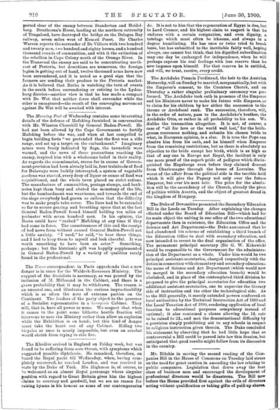The Duke of Devonshire presented the Secondary Education Bill in
the Lords on Tuesday. After explaining the changes effected under the Board of Education Bill—which had for its main object the uniting in one office of the two educational departments then in existence, the Education Office and the Science and Art Department—the Duke announced that he had abandoned his scheme of establishing a third branch of the Education Office to deal with secondary education, and now intended to revert to the dual organisation of the office. The permanent principal secretary (Sir G. W. Kekewich) would be responsible to the Government for the administra- tion of the Department as a whole. Under him would be two principal assistant-secretaries, charged respectively with the duties in connection with elementary and secondary education; the name of Science and Art Department (which would now be merged in the secondary education branch) would be abolished, and in place of the contemplated third division he proposed to give the principal secretaries for education two additional assistant-secretaries, one to supervise the literary side of instruction and the other the technological side. As to the Bill generally, it merely extended powers conferred on local authorities by the Technical Instruction Act of 1889 and the Local Taxation Act of 1890, rendering application of local taxation to educational purposes compulsory instead of optional; it also contained a clause allowing the id. rate to be raised to 2d., and met the denominational difficulty by a provision simply prohibiting aid to any schools in respect to religious instruction given therein. The Duke concluded his statement by observing that he had little hope that so controversial a Bill could be passed into law this Session, but anticipated that good results might follow from its discussion in the country.


















































 Previous page
Previous page